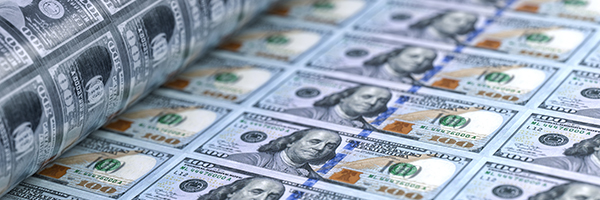Morning Briefing

March 21, 2024 | Daily JAM, Morning Briefing |
Initial claims for state unemployment benefits dropped 2,000 to a seasonally adjusted 210,000 for the week ended March 16, the Labor Department reported today, March 21. Economists polled by Reuters had forecast 215,000 claims in the latest week. Continuing claims for unemployment increased 4,000 to 1.807 million during the week ending March 9, the report on Thursday showed. The Federal Reserve has been looking for signs that the labor market is weakening before raising interest rates. So far the evidence is inconclusive.

March 20, 2024 | Daily JAM, Morning Briefing, Short Term |
The Federal Reserve unanimously voted to leave the benchmark Fed Funds rate in a range of 5.25% to 5.5%, the highest since 2001, for a fifth straight meeting. They left their projections in the quarterly Dot Plot for the Fed Funds rate by the end of 2024 at 4.6%. That was the same projection as in the December Dot Plot. And nothing in either the post-meeting press statement or in Fed chair Jerome Powell’s press remarks changed the timing on when the Fed will make its first interest rate cut.

March 19, 2024 | Daily JAM, Morning Briefing |
Chipotle Mexican Grill (CMG) said on Tuesday, March 19, that its board of directors had approved a 50-for-one split of its common stock.
March 18, 2024 | Daily JAM, Morning Briefing |
About 8.5% of credit card balances and 7.7% of auto loans moved into delinquency in the fourth quarter of 2023, the Federal Reserve Bank of New York reported last week. “Credit card and auto loan transitions into delinquency are still rising above pre-pandemic levels,” said Wilbert van der Klaauw, economic research advisor at the New York Fed. “This signals increased financial stress, especially among younger and lower-income households.” Total household debt increased by $212 billion last quarter to $17.5 trillion

March 16, 2024 | Daily JAM, Morning Briefing |
There’s room for disappointment in Wednesday’s Dot Plot projections from the Federal Reserve. Economists surveyed by Bloomberg were still expecting the Federal Reserve to cut interest rates three or more times in 2024 with the first cut coming in June. (To be more precise, the survey found that a majority expect three or more cuts in 2024 while more than a a third expect two or fewer cuts in 2024.) The survey was conducted from March 8 through March 13. Why do I highlight the dates?

March 14, 2024 | Daily JAM, Morning Briefing, Short Term |
It’s becoming a refrain. Today another inflation measure came in hotter than expected. Which is the problem. It’s har to ignore the possibility that inflation has stopped its steady decline and its recent months has started to move up again. Is there a problem here beyond a stickiness in prices that is preventing the Federal Reserve from reaching its inflation goals? And that might be endangering even a June timetable for an initial interest rate cut? Prices paid to U.S. producers rose in February by the most in six months.

March 13, 2024 | Daily JAM, Morning Briefing |
There’s not much question of what the Federal Reserve will do at its March 20 meeting. The odds–99% on the CME Fed Watch Tool–are that the Fed will do nothing and leave interest rates at the current 5.25%-5.50% benchmark. But that day the Fed will also release its most recent quarterly revision of its economic projections for the year ahead, the Dot Plot. And those projections will have, potential, market moving power. The central question: Will the Fed hold to its projection of 2 interest rate cuts in 2024 or will the bank, worried by recent evidence that inflation has been stubbornly high in recent months, point toward just one cut by the end of the year?

March 12, 2024 | Morning Briefing, Short Term |
Core CPI inflation came in hotter than expected in February for a second straight month. The core Consumer Price Index, which excludes food and energy prices, increased 0.4% from January, the Bureau of Labor Statistics reported today. The year over year inflation rate rose to 3.8%. Economists had been projecting 3.7% annual rate. Core CPI over the past three months rose an annualized 4.2%, the highest annual rate since June. That adds to worries that the improvement in inflation has stalled in recent months.

March 10, 2024 | Daily JAM, Morning Briefing |
A month after the stock market was rocked by a worse-than-expected inflation report, investors are fearing a reprise when the latest data arrives on Tuesday. Last Thursday stocks rallied when Fed Chair Jerome Powell said in his testimony before the Senate that the central bank is “not far” from being ready to cut interest rates. But this week Fed officials are in their regular blackout period ahead of their meeting on March 19 and 20. Absent Fed commentary on the inflation report, stocks may be volatile again.

March 8, 2024 | Daily JAM, Morning Briefing, Short Term |
Can we just agree that they way we measure the labor market is nuts? Today’s report on the U.S. economy is a case in point. Employers added 275,000 jobs in February, the Labor Department reported Friday. But the unemployment rate rose to 3.9% from 3.7%.

March 7, 2024 | Daily JAM, Mid Term, Morning Briefing, Stock Alerts |
Right now Tesla (TSLA) is a case study in how sentiment on a stock changes, how long it takes sentiment to change (and recover), and the stages of sentiment change. You understanding of this process should be our guide to whether you want to own Tesla and when. Tesla (TSLA) could potentially lose money in 2024, Morgan Stanley’s Adam Jonas wrote in a note to investors this week. And he cut his Tesla earnings projections by 25% to $1.51 a share from a prior $2.04. Gross profit margins will fall to 11.4% (excluding regulatory credits that Tesla gets paid by automakers looking to meet EPA mileage and emissions rules.) And this is from a Tesla bull.

March 5, 2024 | Daily JAM, Jubak Picks, LLY, Morning Briefing, NVO, Volatility |
Back on February 20, I posted a video recommending a buy of Novo Nordisk (NVO). In the video, “Buy GLP-1,” I said that the stock, along with Eli Lilly (LLY) was riding the momentum of increased sales of GLP-1 drugs, originally developed to treat diabetes, as weight-loss drugs. Buy, I said, despite the huge run-up in the shares, because new trials and analysis of existing data were pointing to expanded uses for the drugs. Today, Novo Nordic announced exactly the kind of news that I had talked about.












